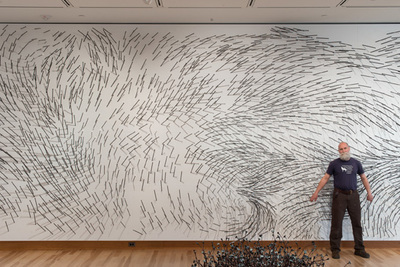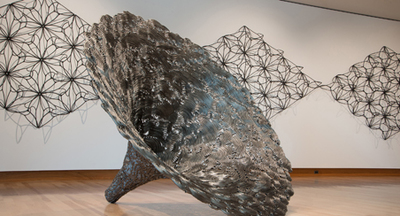John Bisbee: New Blooms
by Cynthia L. Close
John Bisbee: New Blooms
Shelburne Museum
Through May 26, 2014
Could there be a more humble medium for a sculptor than the 12-inch common nail? Maine artist John Bisbee shows us the profound transformations that can be wrought from this common industrial material in a most engaging exhibition in the Shelburne Museum’s new Pizzagalli Center for Art and Education.
Using heat and cold and much physical exertion including hammering, bending, twisting, folding, flattening and unexpectedly, computer technology—the nail undergoes a complete metamorphosis, at times rooted to the ground as in the monolithic Seed, 2013, or it appears airborne as in the wall sculpture Pelt, 2014.

Seed, 2013

John Bisbee in front of the work Pelt, 2014
The varied surfaces of the floor sculptures invite being touched. We are drawn toward the untreated, darkly gouged Seed, tempted to run our fingers along the form, following the light as it settles as shadow into nooks and crannies. The light then appears to mimic sound as it reverberates off the burnished sheen of Hearsay. Both pieces are fixed in time and space, unlike Thicket, whose elongated stems, gathered in clusters or in single stalks, can be rearranged at will, and the possibilities seem infinite.

Hearsay, 2014

Thicket, 2014
All artists are to some extent magicians whose process can seem mysterious. After seeing the awe-inspiring wall pieces that wrap around the entire gallery, my first thought was, “How did he do that?” Although there was a video monitor mounted in a corner that showed Bisbee at work with his forge and welding equipment, I had to ask the well informed docent who was present during the installation how a piece as complex as Pelt was realized, since it was entirely constructed with nails in their original state. It turns out that a computer program calculated the depth and angle of the holes drilled into the wall panels that were mounted according to a predetermined scheme. The nails, hundreds of them, were then driven in by hand during the installation.
John Bisbee had spent nearly three decades working with nails in his Maine studio before Thomas Denenberg, the Shelburne Museum director, approached him about being the first contemporary artist to have a solo exhibition in the “soon-to-be-constructed” Pizzagalli Center. The seven pieces—three floor sculptures and four wall works—were created over the past two years specifically for this show. It was an act of faith for both artist and curator, but it has all come together as a satisfying whole in this most ambitious exhibition.
